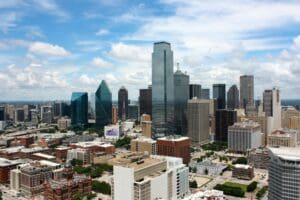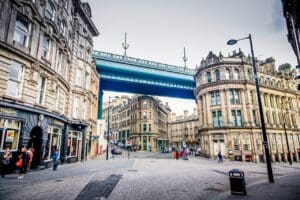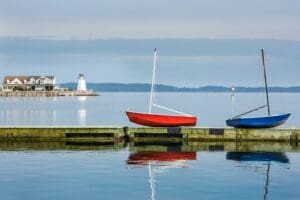By: CALEB BRENNAN
When the COVID-19 lockdown went into effect, child welfare advocates and pediatric experts feared that child abuse that would have otherwise been noticed would remain undetected. It was a logical enough fear, because sites where abuse is often discovered—schools, doctor’s offices, religious centers, and other community spaces—were closed. The economic stressors created by the ensuing explosion of unemployment would likely contribute to a spike in child maltreatment, it was thought. This theory was so strongly believed that even the absence of child abuse reports during the initial lockdown was seen as evidence that malicious treatment by parents was a cause for concern.
But with multiple years of data to comb over, the verdict has proven to be quite the opposite: Physical child abuse dipped substantially, according to a recent analysis of child abuse indicators and statistics published in a journal of the American Medical Association—in large part due to the substantial government investment in keeping families financially afloat during the economic shutdown.
It illustrates a major analytical error underpinning American child abuse policy. Appalling cases of beating or rape of children are a major political motivation behind child protective services (CPS) and their habit of “child separation,” or taking kids from their families and placing them into foster or group homes. But in reality, a large and growing majority of child abuse is simple neglect, which can be greatly ameliorated with the welfare state; and CPS actions are themselves often abusive.
Thanks to decades of PSAs and cultural osmosis, Americans often imagine child abusers as either vicious predators or fiendish, vindictive parents who wish to do intentional harm to their offspring.
In our popular media, this runs the gamut from the abrasive and revanchist punishment of Piper Laurie’s character in the film Carrie to the sensitive acknowledgments between Matt Damon and Robin Williams in Good Will Hunting. In our news, we are horrifically entranced by both the systemic routine abuse perpetrated by religious leader Warren Jeffs and the bizarrely intimate, idiosyncratic manipulations of Munchausen by proxy cases like that of Gypsy Rose Blanchard. In our literature, books like A Child Called “It”—which chronicles one man’s childhood experience with more than a decade of jaw-dropping abuse at the hands of his mother—consistently sell millions of copies.
And, in the age of QAnon, deranged moral panics about child abuse are once again rampant. A July 2022 study from the University of Miami found that of the 2,000 adults surveyed, a third believed that “members of Satanic cults secretly abuse thousands of children every year,” and a quarter thought “Satanic ritual sex abuse is widespread in this country.”
But such inflammatory portrayals of child abuse obfuscate the unfortunate mundanity of the situation. “Almost none of [the cases of abuse] are like the horror stories, but … when you hear the words child abuse, people generally think of rape, murder, and torture that exists, but it exists in very, very small amounts,” says Richard Wexler, executive director of the National Coalition for Child Protection Reform.
“That doesn’t make them any less serious. But it does have a profound effect on how you try to solve that problem. Meanwhile, the system grows and it grows and it grows and laws and definitions are expanded,” Wexler explained.
Studies bear out Wexler’s observations. What happened during the pandemic follows a longer trend of a steady, 30-year decline in physical and sexual child abuse—while the overall quantity of maltreatment remained roughly steady. The reason is neglect—defined as a failure to provide basic needs like food, shelter, medical care, or safety—which has increased, accounting for more than three-fourths of all child abuse cases and 1,750 deaths in 2020.
While neglect also diminished during the pandemic, this de jure category of maltreatment still remains the major reason for intervention by CPS and its use of family separation. Most of the time when agents of the state are snatching children away from their families, it is because of neglect, not beating or sexual abuse. There have been something like nine million child separations over the past 20 years, and the investigation of countless more. Unsurprisingly, there are deep racial disparities: Of the 1 out of every 3 children investigated by CPS for abuse or neglect, 53 percent are Black.
A growing chorus of child welfare professionals, legal specialists, and parents separated from their children under such guidelines are harshly critical of this approach, arguing that it ensures that instances of neglect caused by economic precarity are treated as equivalent to cases of parental sexual abuse. Many times, these critics argue, such policies criminalize poverty and do little to meaningfully intervene in the widespread and often overlooked crisis of rampant child poverty in the most industrious and wealthy country on Earth.
Jey Rajaraman, an attorney who spent 15 years as the chief counsel of Legal Services of New Jersey’s Family Representation Project, argues that the child welfare system’s overreliance on courts and family separation has proven especially unhelpful in actually dealing with the holistic causes of what we define as neglect. In many cases, the problem is simply that parents do not have enough money to provide a baseline standard of living for themselves or their kids, and separating them is not a humane way to fix that problem.
“I’ve done this for close to 20 years now, and I honestly can say I’ve never had a case or a parent I defended where I was like, ‘Oh, I’m so glad they took their kids or I’m so glad their rights are terminated,’” Rajaraman said.
This can in part be attributed to child welfare cases being deeply related to issues of poverty such as lack of income for new, clean clothes, rather than particularly violent or sexually exploitative incidents. The official statistic is that 47 percent of cases are linked to matters of financial instability, but this does not include variables like child care or inability to afford health care—an extremely problematic issue for working-poor parents who work extra hours and have long commutes.
“It’s always been the other way around. Like, if they were provided a system that supported them, this would not have happened. We have to really think about what we’re doing to families: Drug use and being poor or struggling is not a reason to intervene or interfere [with family separation],” Rajaraman continued.
Indeed, in many cases, separation actually enables the worst kinds of abuse. Many such children are sent to foster homes or group homes, where, ironically, sexual abuse is four times and 28 times more likely to happen, respectively.
ONE CAN EASILY FIND UNDENIABLE CASES of economic deprivation that could constitute child maltreatment. Deamonte Driver, for instance, was a 12-year-old boy whose toothache turned deadly back in 2007. All he needed was a standard $80 tooth extraction, but his family had recently lost their Medicaid coverage, and his mother couldn’t spare the cash. The infection traveled into Driver’s brain and eventually killed him.
Such conditions also create a negative-feedback loop: The stress of poverty can induce mental unwellness in parents, resulting in higher levels of depression, anxiety, and substance abuse—thus creating the conditions for CPS to interact with families. And since poor families rely on services like Temporary Assistance for Needy Families (TANF), Medicaid, and Section 8 housing, they are more likely to come in contact with—and be surveilled by—state entities that are entwined with CPS.
As Dorothy Roberts’s new book, Torn Apart: How the Child Welfare System Destroys Black Families—and How Abolition Can Build a Safer World, argues, CPS is essentially a police agency and thus carries all the well-known pathologies of American police departments.
Moreover, caseworkers operating under the authority of CPS are able to probe and investigate families in ways in which traditional law enforcement officers cannot, and because child welfare operates under the umbrella of civil legality, the Fourth Amendment’s protection against unreasonable searches and seizures is not always applicable.
“All it takes is a phone call from an anonymous tipster to a hotline operator about a vague suspicion to launch a life-altering government investigation,” Roberts, a law professor at the University of Pennsylvania, writes.
“A child might seem unkempt or unattended. A parent might be observed smoking marijuana. A house might appear dirty. Most of the people investigated by CPS are unaware of their rights or the name of a lawyer to call when a caseworker rings the doorbell without warning.”
Instead of having a teacher report a case of child malnutrition to CPS for investigation, we should simply allocate more resources so a family can eat.
Much like with American policing more broadly, Roberts contends, this form of “public safety” actually targets Black and brown communities rather than addressing the material concerns that create the conditions for child neglect. This, in turn, transforms family poverty into a proxy criminal offense and makes parents culpable actors.
“This isn’t a system that cares about parents. The money tells you that, right? What we know is that, you know for every seven dollars we spend on adoptive services, we spend one dollar on reunification. It isn’t funded to support families. It’s funded to keep the machine working,” Shrounda Selivanoff, director of public policy at Children’s Home Society of Washington, told the Prospect.
Selivanoff, who was charged with neglect while struggling with addiction in 2007, is intimately aware of the byzantine and irrational policies that govern child welfare.
“I don’t think that it’s an accident that we have the majority of folks in child welfare that don’t need to be there,” she added.
EVEN WHEN THE VULNERABILITIES that create neglect aren’t inherently present, CPS still cracks down on struggling families. Iesha, a mother of three from New Jersey, was separated from her children following an episode of domestic violence perpetrated by her children’s father. When both parties were arrested and Iesha was sent to transitional housing for battered women, CPS separated Iesha from her children.
“They removed the children that night because I didn’t have anyone there that could care for them, no one after that was qualified to care for them, and they didn’t think I was qualified to care for them,” she told the Prospect while making her way to her daughter’s cheerleader performance.
“So they decided that I needed intensive therapy and to move to a shelter where they told me that’s where I would get my children back … but then they told me that wasn’t stable housing, and that the children couldn’t come to live with me there,” she said. Even then, Iesha made sure the spare room in her shelter was prepared for a visit from her children.
Iesha argued that CPS penalized her for being a victim of domestic violence: “Basically, they told me that I was endangering my children by choosing an abusive man. So they wanted to make sure that I wouldn’t fall into the same pattern before they decided to give me my children back.”
That CPS decision kept Iesha away from her children for four years. She did eventually regain full custody, but the period of separation has left understandable scars. “They see police lights now and they get scared. Somebody knocks on the door, and they don’t want to answer it,” she said, her voice cracking.
“We never really knew how it was going to affect them until later.”
The issue, advocates for intensive reform say, is the ability of CPS and family services to liquidate—rather than provide for—poor families that supposedly neglect their children. For example, instead of having a teacher report a case of child malnutrition to CPS for investigation, we should simply allocate more resources so a family can eat.
The data backs this up: According to a 2021 study by the University of Washington, a 10 percent increase in the allotment of cash to families from the Earned Income Tax Credit resulted in a 9 percent decline in neglect cases.
The best policy in American history along these lines was President Biden’s Child Tax Credit expansion, which provided some 35 million families with $3,600 for each child under age 6 and $3,000 for children ages 6 through 17. Despite some technical flaws, that’s the kind of universal welfare state policy that would seriously cut down on child poverty and therefore child neglect. Alas, it expired this past January thanks to Sen. Joe Manchin (D-WV), who was reportedly convinced that poor families would spend the money on drugs.
Until politicians shake off these notions, an expansion of national, universal cash assistance, social housing, and health care will remain impossible—despite these being far and away the best tools for fighting child poverty and all its associated problems.
“In child welfare, you might hear about inadequate income, lack of child care, unstable housing or food insecurity—any of those things,” says David Kelly, a human rights attorney who worked with both the Obama and Trump administrations on child welfare but now directs Family Integrity & Justice Works.
“The most helpful response would be to try to address some of those needs, but the more common response is to blame the parent, to see the parent as unfit because those needs aren’t met, and, potentially, remove a child.”
Throughout the Trump years, there was a deep (and understandable) preoccupation with family separations carried out through the immigration system. But until we respond to the economic deprivation that leads to similar separations with the same sense of urgency, thousands more children will be cruelly severed from their families—and liberal policymakers will have only their austerity mindset to blame.





















